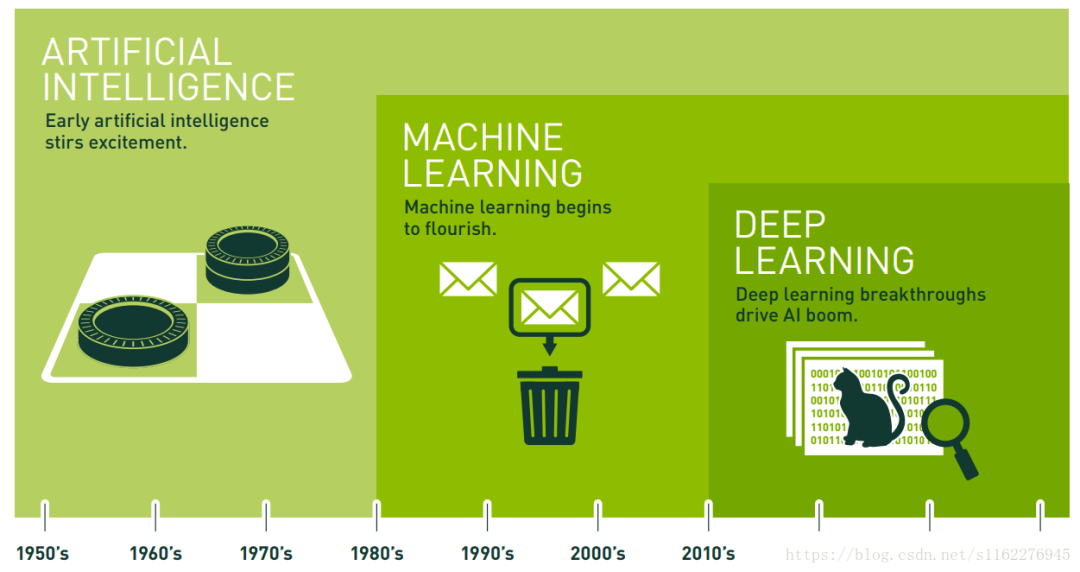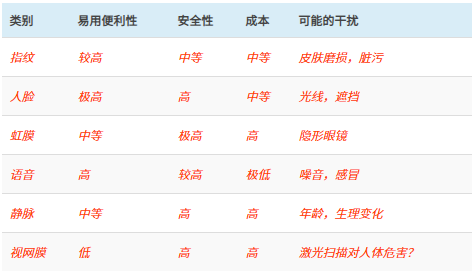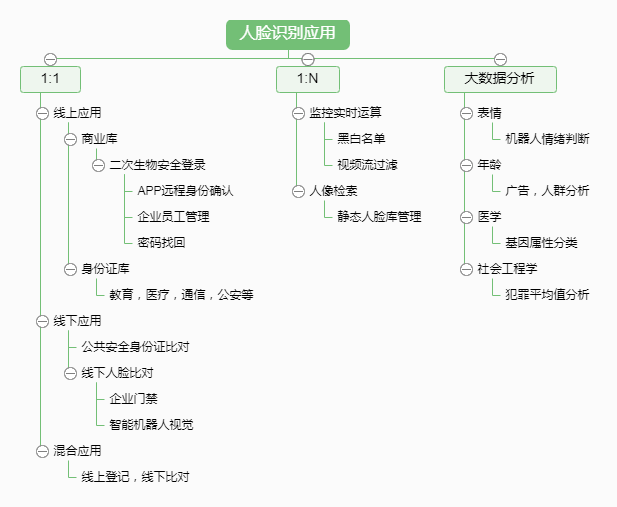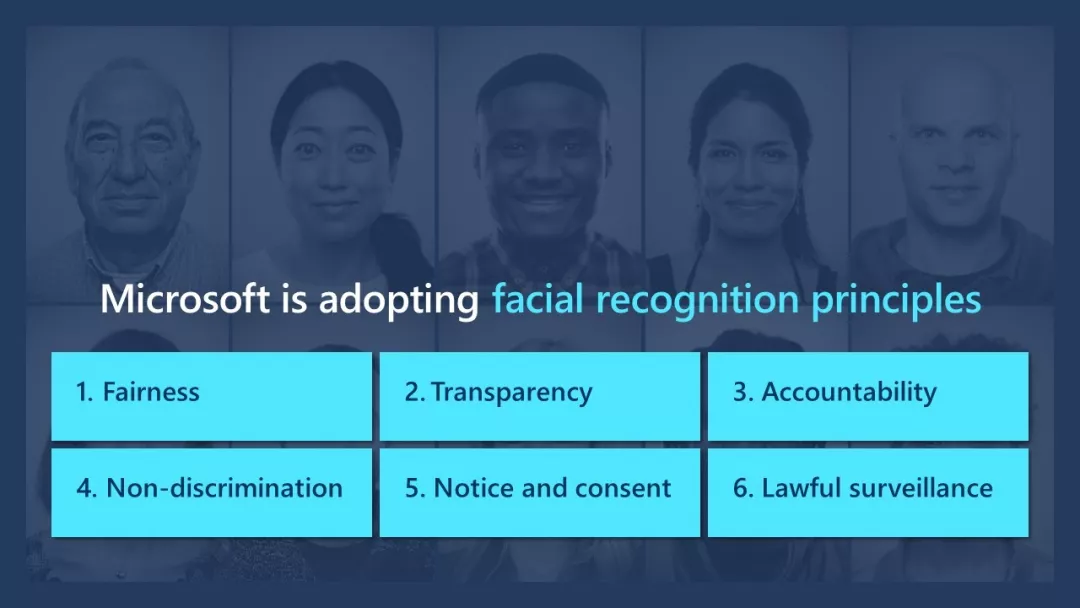Ⅰ. Definition of face recognition
Face recognition technology began in the early 1970s and is a typical application in computer vision (CV). Computer vision belongs to deep learning (DL).

At the same time, face recognition is also a kind of biometric identification technology. Other biometric identification technologies include: fingerprint, iris, voice, vein, retina. Compared with other biometric technologies, face recognition has the characteristics of non-contact, non-mandatory, convenient, parallel processing and so on.
Comparison of different biometric technologies

The purpose of face recognition is to judge and identify the information of faces in pictures and videos (videos are composed of pictures), and to detect, identify and track the faces in images and videos.
Ⅱ. Classification of face recognition algorithms
Traditional human-designed features and machine learning techniques, including geometric methods, holistic methods, feature-based methods, and hybrid methods.
Current deep learning methods are based on deep neural networks (DNN) and convolutional neural networks (CNN) trained on large datasets.
The reason why the early use of CNN deep learning face algorithm was not effective was due to insufficient computing power and data volume.
At this stage, with the support of big data and computing power, the accuracy of face recognition of various algorithms is already very high. Facebook's DeepFace achieved an accuracy of 97.35% on LFW, and then Google's FaceNet achieved it on LFW. 99.63% accuracy. The current development direction in the field of face recognition is lightweight (easy to deploy to mobile terminals) and hardware-based modularity.
Ⅲ. The process of face recognition

1. Face detection.
The face detector is used to find the location of faces in the image, and if there are faces, returns the coordinates of the bounding box containing each face.
2. Face alignment.
The goal of face alignment is to scale and crop the face image using a set of reference points located at fixed locations in the image. This process usually requires the use of a feature point detector to find a set of facial landmarks, in the case of simple 2D alignment, to find the best affine transformation that best fits the reference point. More complex 3D alignment algorithms can also achieve face frontalization, that is, adjust the pose of the face to face forward.
3. Face representation.
In the face representation phase, the pixel values of the face image are converted into compact and discriminable feature vectors, which are also called templates. Ideally, all faces of the same subject should map to similar feature vectors.
4. Face matching.
In the face matching building block, two templates are compared, resulting in a similarity score that gives the likelihood that both belong to the same subject.
Ⅳ. The application of face recognition

Ⅴ. Difficulties in face recognition technology
Head posture
Most face recognition algorithms are mainly aimed at frontal and quasi-frontal face images. When the pitch or left and right deflection is relatively severe, the recognition rate of the face recognition algorithm will drop sharply.
Age
On the other hand, the validity period of my country's ID card is generally 20 years. During the 20 years, everyone's appearance will inevitably change a lot, so there are also big problems in the identification of ID card photos.
Occlude
Cover your face with glasses, hats, etc.
Lighting conditions
Human face expressions.
The level of refinement of expressions and the diversification of expression categories.
Face anti-counterfeiting
Fake face, how to detect liveness.
Ⅵ. Think
Privacy and security
Ensure informed, explicit consent. Li Yanhong said that everyone is willing to trade privacy for convenience. In China, due to people's inclusiveness of new technologies, these three elements of AI have been comprehensively broken, and people do not care about data called "personal privacy". Recently, the first case of face recognition in Hangzhou was pronounced. The buyers of the house were recognized by face, and the cases of big data killing, etc., should give some inspiration to relevant domestic face recognition research enterprises, government agencies, and users of face recognition technology products.
The technology is not perfect
At present, face recognition technology is lacking in identifying people of color, distinguishing female gender, twins, etc., involving issues such as racial discrimination and sexism.
Photo spoofing problem, how to enhance liveness detection.
Data protection
How to ensure data security in the process of face recognition data collection, transmission, storage, use, and destruction.
Whether it is used by government agencies, whether it violates democratic freedom and human rights!
Typically, for example, in the American TV series (Person of Interest / POI), the scenes of being monitored anytime, anywhere, and facial recognition are believed to be unwilling to see.
6 principles that Microsoft's face recognition research work follows

Ⅶ. Representative companies of face recognition
At present, in the field of face recognition, Chinese companies are very active and outstanding. Representative companies include Sensetime, MEGVII, YITU, Cloudwalk, Hikvision, Baidu, Alibaba, and Tencent. Research institutions include the Tang Xiaoou team of the Chinese University of Hong Kong (actually the technical team of SenseTime, and the founder of MEGVII also studied under Professor Tang Xiaoou).
There are many achievements in the early face recognition field of foreign companies, such as DeepFace of Facebook and FaceNet of Google. Due to policy and legal considerations, it has been inactive in recent years. Representative enterprises are Google, Microsoft, Facebook, etc. In June 2020, IBM announced that it would retire face recognition technology and shut down all related research and development.
 English
English 日本語
日本語 한국어
한국어 français
français Deutsch
Deutsch Español
Español italiano
italiano русский
русский português
português العربية
العربية tiếng việt
tiếng việt ไทย
ไทย čeština
čeština dansk
dansk Svenska
Svenska





